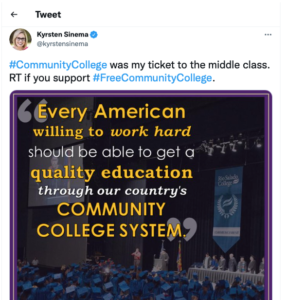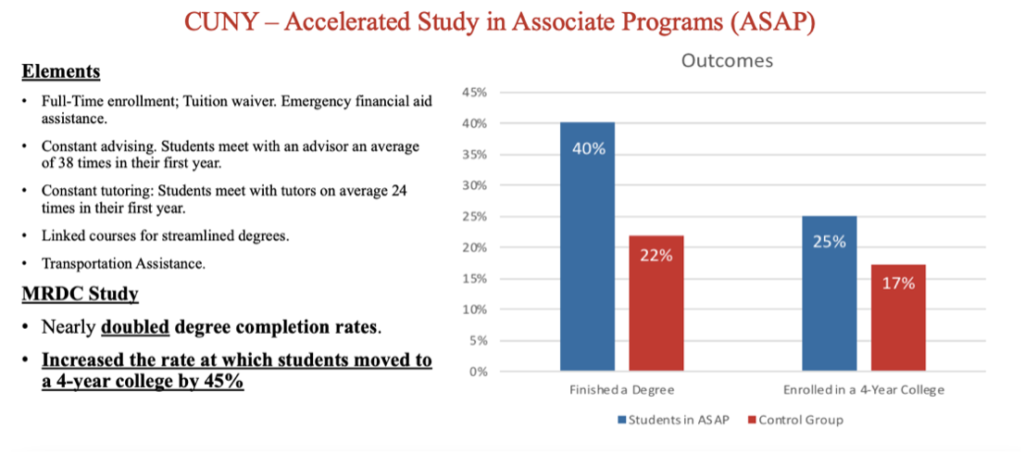The Biden free community college plan is out of the Build Back Better reconciliation plan, according to media reports. While we supported the Biden plan, there was always a better design option. A debt-free college promise that is: (1) extended to two and four-year public colleges; (2) targeted on deserving and needy students; and (3) coupled with robust direct aid to institutions in support of college completion is smart politics and good policy.
But before anyone declares the free college movement dead and buried, consider two things. First, there’s the good already accomplished with the Biden free community college proposal. Community colleges have gone from being the forgotten child to being the favored child of higher education in the eyes of the vast majority of Democratic politicians.
Heightened attention to community colleges is good given their disproportionately needy student population, relative underfunding, and need for improvement, which is great.
Take a look at community college funding in Virginia – the home of House Education and Labor Committee Chairman Bobby Scott (D-VA)– where community colleges receive barely two-thirds as much in state higher education funding as four-year public colleges despite serving a much needier student population and the latter having exponentially greater wealth.
Second, keep in mind how far the idea of free college has come. The idea of “College For Everyone” has been percolating for years dating to a speech by John Edwards, yes, that John Edwards, back in 2002.
Sometimes big policy changes take multiple debate cycles to be realized. Look at the move to direct student loans that financed a massive increase in Pell Grants. Look at health care. It is exceedingly rare that a major legislative initiative is not declared dead at least once before rising from the ashes and being enacted in some form or another. Take the long view.
Going forward, on political and policy grounds, at the federal and state levels, the free college movement would be wise to expand its base and narrow its focus.
Only a little over 40 percent of postsecondary students attend community colleges. That number jumps to nearly 75 percent when you add in four-year public colleges.
And consider the subset of suburban swing voters that play an outsized role in national elections. Many of those folks do not aspire to send their kids to community college, nor worry about community college costs. They’re anxious about the cost of four-year colleges.
The politics of free college improve further when you add in a work or service component. Conservative Democrats like Joe Manchin (D-WV) are wary of new entitlements, but when a debt-free college promise only conveys upon evidence of student responsibility, support grows. See Kyrsten Sinema’s (D-AZ) tweet below.

The same holds for targeting. Remember when Pete Buttigieg campaigned in 2020 against a non-means-tested free college program? He surely was aware of the polling edge. Below is our never before released September polling on the issue.

Support for tuition and fee “free college” increases to near 70% when targeted on working class and low-income students (i.e., Pell Grant eligible) and extended to two and four-year colleges.
Turns out all these changes that strengthen political support are or lead to good policy, as well.
When four-year as well as community colleges are included in a debt-free college promise program, students are better able to attend the institutions that are the best fit for them. They are not de facto segregated into two-year schools.
The research indicates that if a student is qualified to attend a four-year school but chooses a community college instead, they are 30 percentage points less likely to complete a degree. If you think about it, that makes sense. Four-year colleges are better financed, have more support student services, and are filled with peers focused on degree attainment.
The research also indicates that when students devote a reasonable amount of time in college to work or service, attainment goes up. There’s a tipping point. Work 20 hours or more and the odds of completion go down. But those who work or serve 10-15 hours a week while in college manage their time better, take their studies more seriously, and report higher grades.
Finally, targeting support on financially hard-pressed families is good policy as well, insofar as it frees up funds for a more robust initiative that includes support to students for costs over and above tuition and fees like those for room, board, and other expenses. And it frees up funds to directly support colleges in boosting degree completion rates.
There are numerous examples of colleges that evidence relatively high degree completion levels compared to peer institutions serving similar students. The not so secret recipe is partnerships with school districts and community-based organizations that ensure completion of a college prep curriculum in high school, sufficient financial aid to assure full-time college attendance, use of big data analytics to target support services on campus, quality advising, and academic tutoring for those flagged as at-risk.
The gold standard completion program is the CUNY ASAP program now being implemented in Ohio as well. It’s nearly doubled completion rates according to multiple independent studies.

So, the better political and policy path for the free college idea is clear: go big and focus on deserving, needy and middle income students.
Advocates, Democrats in Congress, and most significantly the Biden administration just have to adjust their initial staked out positions a bit and keep at it.
It isn’t over until we say it’s over.
# # #